Science Water Systems Quiz #1
Topics
Water - What Do You Know/ (Pre-Quiz)
Water on Earth
The Water Cycle
Ecological Footprint (water conservation)
Water In the News
What is Runoff?
A River’s Journey
Flood Plains
Drainage Basins
Groundwater
Water Tables
Water Above and Below Ground
Comparing Oil Spills
Environmental Consequences of Oil Spills
Question Types
Fill in the blank
Short (very) answers (listing, one/few word answers)
Multiple Choice
Water What Do You Know? (Pre-Quiz)
1. Approximately what percentage of earth is covered by water? Land?
approximately 71% water and 29% land.
2. Why are these numbers only approximations?
These numbers are only approximations because it is always changing since water is constantly moving (H2O cycle)
3. Does ‘freshwater mean the water is clean?
No, it does not.
4. Does freshwater have salt in it?
Yes, it has trace amounts.
5. Much of the water that goes to homes in the GTHA comes from Lake Ontario. What needs to be
removed from Lake Ontario water before it can safely be consumed? List as many things as
possible?
Living things, dirt, germs, salt, rocks/other objects, minerals, bacteria, animals, etc.
6. Define salinity.
The amount of salt (written in a percentage) in a body of water. 1.5%
7. What is the difference between a swamp and a marsh?
A swamp is wetland that has large trees/shrubs, whereas a marsh is a wetland that has small bushes/veg.
8. What is an estuary?
A small stream fresh/salt water misi.
9. Where in Canada can you find an estuary?
St. Lawrence River.
10. There is very little biodiversity found in an estuary. Why?
There is very little biodiversity found in an estuary because it is the point where fresh water and salt water converge therefor many species can’t adapt to the conditions.
11. Name all the oceans.
Atlantic Ocean, Pacific, Indian, Artic, Southern.
12. Water if found throughout our entire planet in all three states of matter. Give an example of each.
Solid - glacier
Liquid - lake
Gas - water vapor
Water on Earth
WOE Definitions
transpiration: evaporation of water from living things, mainly plants
infiltration: process by which surface water enters the soil
water cycle: a continuous pattern in nature in which water moves as it changes state, above, on, and below the surface of earth, there is no beginning or end to the cycle.
Conditions
There are two main conditions that determine which state water is in, temperature and altitude.
Temperature When the temperature is very low, water changes from liquid to solid, in the form of snow, frost, ice, etc. When the temperature is high, water changes from liquid to gas, in the form of steam. High temperatures also increase the rate of evaporation in which water changes to the gaseous state of water vapor.
Altitude It is closely related to temperature. With an increase in height, temperature falls, and this in turn affects which state water is in.
Earth Water
The water on earth is the same it’s always been. water is recycled because no new water is made. water moves through the different places of storage in the water cycle and changes through the 3 states. Water vapor can also come from transpiration from living things.
The Water Cycle
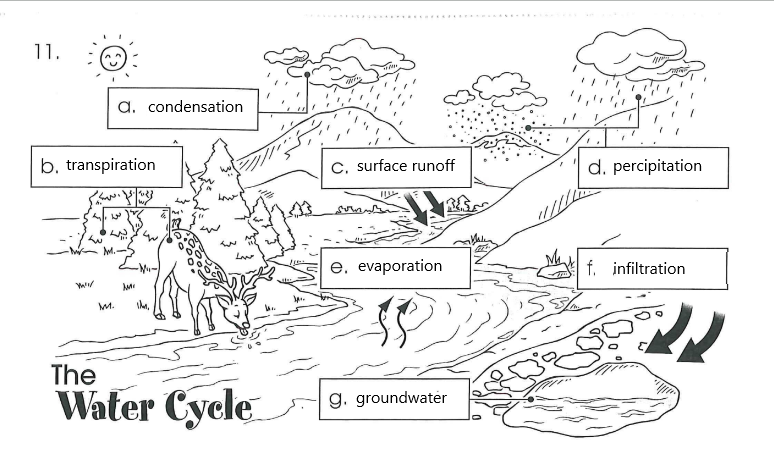 Water from precipitation falls directly or finds its way to water bodies through rivers and streams, while some infiltrates into the ground and becomes groundwater. Evaporation occurs in water bodies and transpiration takes place in living things, through which water changes to water vapour and then condenses to form clouds. With increased weight, water droplets fall back to the Earth as precipitation.
Water from precipitation falls directly or finds its way to water bodies through rivers and streams, while some infiltrates into the ground and becomes groundwater. Evaporation occurs in water bodies and transpiration takes place in living things, through which water changes to water vapour and then condenses to form clouds. With increased weight, water droplets fall back to the Earth as precipitation.
Groundwater
Groundwater is fresh water. It comes from rain that gets into the ground through infiltration.
Examples and Diagrams
A far greater variety of plants and animals live in salt water than in fresh water. Some living things spend part of their lives in salt water and part in fresh water.
salt water: Whales
fresh water: water lilys
both: salmon
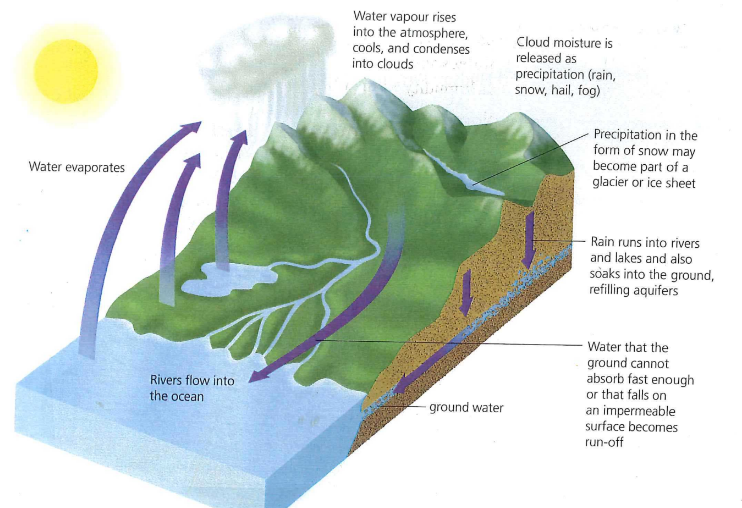
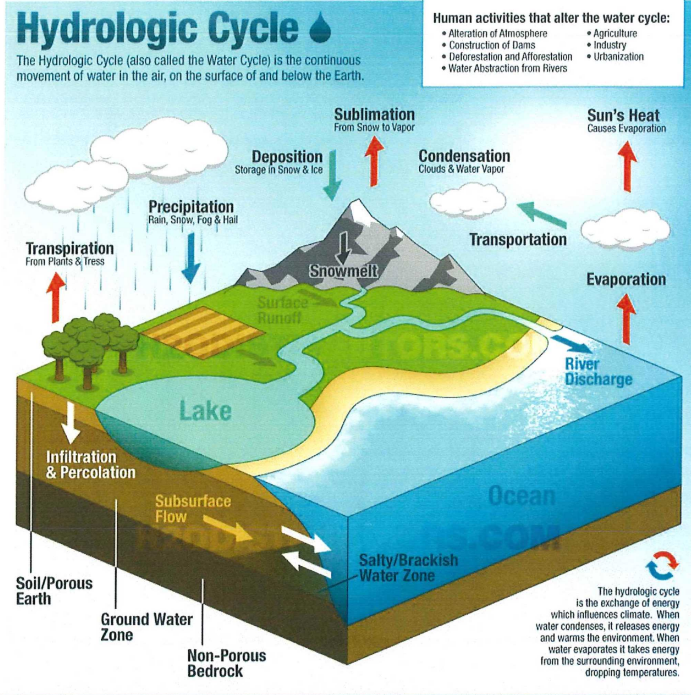
The Water Cycle
Definitions
Melting occurs when thermal energy is applied to ice, converting it into liquid water. This process can also sublimate the ice into water vapor.
Deposition occurs when a gas turns into a solid, like when water vapor is exposed to extreme cold.
Evaporation occurs when a liquid converts into a gas, like clothes drying on a clothesline or water disappearing from a sidewalk. Transpiration describes how water is transferred into the air by plants through evaporation from leaves, stems, and flowers.
Condensation occurs when a gas loses thermal energy, like clouds or dew.
Freezing is the final state when water changes from a liquid to a solid, used in various activities.
The Sun🔆
Thermal energy from the sun causes evaporation, condensation, melting, and sublimation.
Experiencing the Changes of State in Water
You can experience the changes of state in water when your cup transpires when there is ice water in it.
Sublimation v Deposition in Nature
Applying thermal energy to ice also has the possibility of sublimating the water. This means that the ice turns directly into water vapour (gas) rather than melting into water first. Deposition is the opposite of sublimation. It is a less common change in state that occurs when a gas turns into a solid. When water vapor is exposed to extremely cold temperatures, it can change into a solid before being a liquid.
Ecological Footprint
Ecological Footprint Explained
The ecological footprint measures the impact of human activities on nature by assessing the resources consumed and waste produced.It represents the land and water needed to sustain our lifestyles, including food, energy, transportation, and goods/services. By understanding our footprint, we can gauge the pressure on the planet and take steps to manage resources more sustainably. This informs both individual and collective actions toward environmental conservation and wise ecological asset management.
Water Footprint
The passage introduces the concept of a water footprint, which measures the direct and indirect water usage in our daily lives. Direct water footprint accounts for water used for drinking, washing, and cooking, while the indirect water footprint includes the hidden water used in the production, transportation, and disposal of goods. Calculating the water footprint is crucial for understanding our impact on this essential resource and making more sustainable choices. It suggests several actions to reduce water footprint, such as consuming less meat, opting for tea over coffee, and choosing natural foods over processed ones. Ultimately, it emphasizes individual responsibility in reducing water footprint and making sustainable choices to protect this precious resource.
Water in The News
I learned about water pollution, rising sea levels, and the indigenous communitys fight for clean water.
What Is Runoff
Impermeable
Impermeable means allowing no material to pass through.
Six substances trat I know are impermeable to water are raincoats, plastics, metals, glasses, and fiberglass.
Porous
Porous means having tiny holes or pores that allows fluid to pass through.
six porous substances that I know are sandstone, cloths, sponges, ceramics (unglazed), sand,
and wood.
Runoff
Runoff is rainwater that flows off a land surface.
4 factors that affect runoff is the amount of water that flows off the land, depends on surface type, slope steepness, precipitation amount, and time span.
Water behaves differently on different surfaces. Smooth, hard surfaces quickly runs off, while porous surfaces soak in water. This is also true when rain drops hit Earth. Rainwater flows off impermeable surfaces like bare rock and asphalt, and soaks into porous surfaces like gravel and soil. Run-off, the amount of water that flows off the land, depends on surface type, slope steepness, precipitation amount, and time span. Heavy rainfall may run off porous surfaces, and run-off can travel hundreds of kilometers.
A Rivers Journey
Upstream and Downstream
Upstream is direction the water is coming from whereas downstream is the direction that the water is going.
Rivers
Young and Old Rivers A young river is usually narrow, straight, and fast moving whereas old rivers are often slow moving and loop across the broad valley floors.
Rivers v Highways Differences Rivers always flow downhill whereas highways can go uphill. Rivers become broader as it reaches its goal whereas highways typically get smaller.
River Flows Some factors that may make a river flow in a certain direction are the pull of gravity can make the river flow downhill, landslides and earthquakes can make a river change direction, and rocks and boulders can change the direction of the rivers flow.
The Flow Of Water The flow of water and the deposits of sediment and rock that it leaves behind might be useful to a scientist because the types of sediment and rock will indicate the type of rock and soil that can be found upstream and the rate and type of erosion that is occurring.

A Rivers Journey
Rivers and streams connect places like highways, moving in only one direction downhill. They begin on steep slopes, with young rivers being narrow and fast-moving. They tumble down waterfalls, forming white-water rapids and causing erosion. On gentler slopes, rivers move slowly, widening valleys and deepening them. The final destination is a lake or ocean. Before reaching the ocean, rivers cross plains, where they are easily deflected sideways and wind in loops across the valley floor, depositing fine rock particles or sediment.
Valleys and Plains
A valley is a steep channel of land carved by a young river whereas a plain is a wide, gently sloping area of land near the coast.
Flood Plains
Definitions
flood plain: is the part of a river valley where a river may overflow its banks.
levee: elevated ridges that can be built to heighten the sides of a river valley.
meltwater: runoff from melting snow
Overflow and Floods
Some advantages of rivers overflowing are when a river overflows onto its flood plain, it spreads sediments in a thick layer over the valley floor, which makes the flood plains the most fertile farming areas in the world. The rich soil attracts large numbers of people to live on or near the flood plain.
Some disadvantages of rivers overflowing are floods wash away houses, cause billions of dollars worth of damage every year, and can kill or injure people and livestock.
Humans do increase the risk of floods by removing natural vegetation, which increases run-off.
Humans decrease the risk of floods by replanting trees and shrubs, building dams and levees, and digging drainage channels.
A levee could be washed away or covered with water in a severe flood.
Drainage Basins
Drainage
A drainage basin is the total area from which precipitation drains into a single river or set of rivers.
A drainage divide is the boundary of a drainage basin formed by the crest of a hill or mountain.
Map
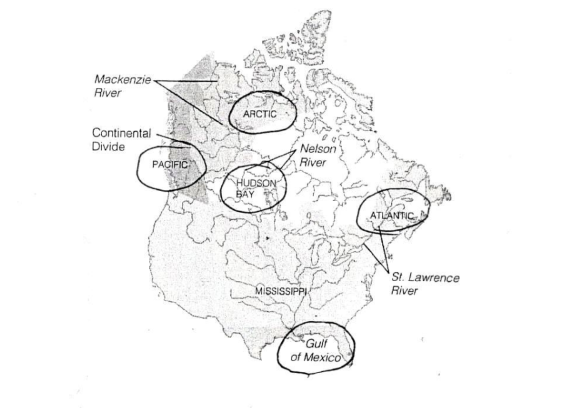 These are the 5 major drainage basins and the continental divide.
These are the 5 major drainage basins and the continental divide.
The Water Table
Water Table
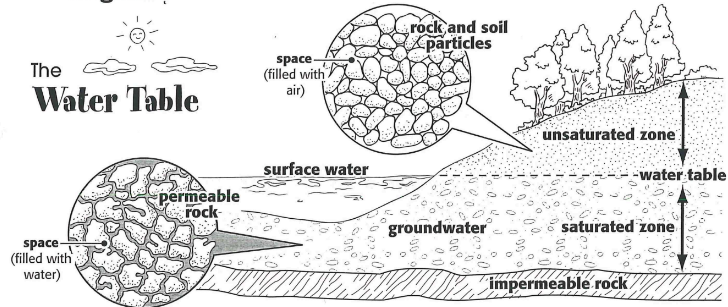 Water soaked through the ground is called groundwater.
Water soaked through the ground is called groundwater.
Factors Affecting a water table are
Rises due to | Falls due to |
|---|---|
Heavy rainfall | bottle water industry |
lake seepage | persistent drought |
melted snow and glaciers | inefficient showers and toilets |
removal of deep rooted trees | groundwater mining |
structural change in soil due to construction |
Aquifer
An aquifer is an underground storage of water.
Water from aquifers was cleaner and safer for drinking than surface water because as water seeped through the soil to aquifers, many pollutants were filtered out.
Agricultural chemicals, landfills, leaking oil tanks, and accidental spills cause the pollution of aquifers.
Another source of pollution could be chemicals.
Affecting Factors
The water table's shape is influenced by land topography, precipitation, plant growth, and human activity.
Surface topography affects the curve of the water table, which forms rivers and lakes.
Changes in precipitation, plant growth, and human activity can also affect the water table.
Inefficient water use, such as excessive watering of crops, can lead to permanent water table drops.
Human activity can permanently affect a water table if humans do not take more water from the ground in a more sustainable way.
Ground Water
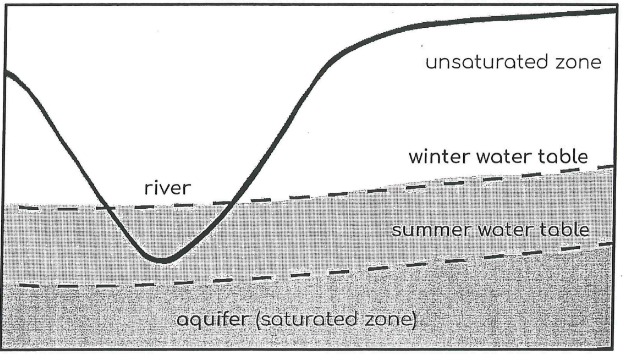 Groundwater table
Groundwater table
Water Above and Below Ground
Definitions
groundwater: groundwater is water located underground within soil and rock.
aquifer: an aquifer is the sone beneath the water table that is saturated with water.
zone of saturation: a layer of porous rock in which all pores are full of water.
water table: the top zone of saturation.
impermeable material: layer below the ground that water can’t flow through, ex. clay.
permeable material: layer below the ground that water can flow through, ex. sand and soil.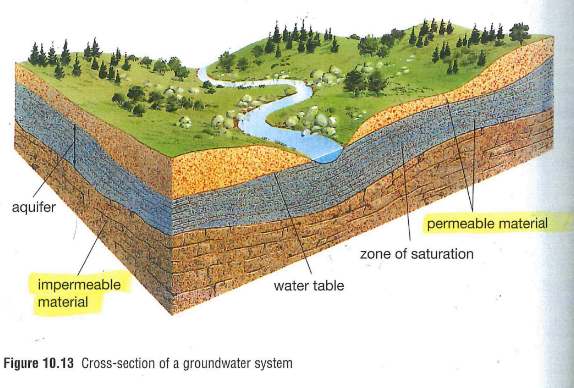
Above and Below Ground
The water in a well comes from a reservoir under the ground. A hole is drilled through soil and rock to a point below the water table and from there water is pumped to the surface.
Hot springs occur where groundwater is heated by rocks that come in contact with molten material under Earth's surface.
Comparing Oil Spills
Exxon Valdez Oil Spill | Deep Water Horizon (BP) Oil Spill |
March 24, 1989 Prince William Sound, Alaska | April 20, 2010 Gulf of Mexico |
Environmental Consequences of Oil Spills
Beaches, Marshlands and Fragile Aquatic Ecosystems
Oil spills have significant and lasting impacts on ecosystems.
When oil reaches beaches, it coats rocks and sand, making the area unusable for wildlife
In wetlands like coastal marshes and mangrove forests, plants absorb oil, damaging them and rendering the habitat unsuitable for wildlife
oil sinks into the marine environment, it harms underwater ecosystems, endangering fish and smaller organisms crucial to the global food chain.
Despite extensive cleanup efforts, studies reveal that oil can persist in the environment for an extended period
Birds
Oil spills have severe consequences for bird populations, especially those that swim and dive for food. These spills damage nesting grounds, with potential long-term effects on entire species.
Oil-covered birds, a symbol of environmental damage, face difficulties in flying and suffer from loss of natural waterproofing and insulation, making them vulnerable to hypothermia or overheating
Even small amounts of oil can be deadly, as birds often swallow it while preening, leading to severe internal organ damage.
Oil spills also disrupt migratory patterns by contaminating stopover areas for migrating birds
Marine Mammals
Oil can clog blowholes of whales and dolphins, disrupting proper breathing and communication
The oil coats the fur of otters and seals, making them open to hypothermia
Even if marine mammals survive immediate exposure, oil spills can contaminate their food supply, leading to poisoning and other issues
Fish
Fish, shellfish, and other marine life are frequently killed by oil spills
It took more than thirty years for the fisheries affected by the Exxon Valdez to recover
Wildlife Habitat and Breeding Grounds
Long-term environmental damage from oil spills extends to species and their habitats, impacting nesting and breeding areas
The oil can damage eggs and affect the development of hatchlings
Oil Spill Terms
absorber: material used to make up boomsthat help absorb oil while it is being contained
boom: an oil-containment device that floats on the surface of
the water and is used as a barrier to keepoil in or out of a specific location
dispersant: chemicals sprayed on oil to cause it to break up and sink
skimmer: a floating boom system